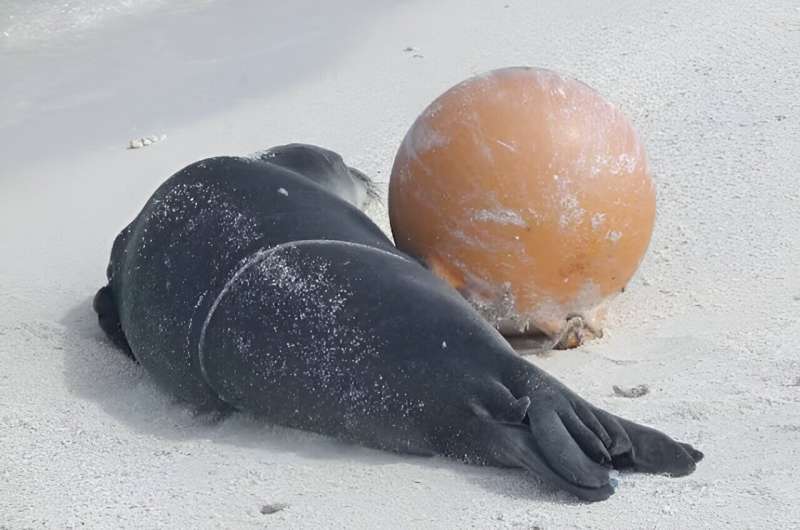This article has been reviewed according to Science X's editorial process and policies. Editors have highlighted the following attributes while ensuring the content's credibility:
fact-checked
peer-reviewed publication
trusted source
written by researcher(s)
proofread
Sharks, turtles and other sea creatures face greater risk from industrial fishing than previously thought

My colleagues and I mapped activity in the northeast Pacific of "dark" fishing vessels—boats that turn off their location devices or lose signal for technical reasons. In our new study published in Science Advances, we found that highly mobile marine predators, such as sea lions, sharks and leatherback sea turtles, are significantly more threatened than previously thought because of large numbers of dark fishing vessels operating where these species live.
While we couldn't directly watch the activities of each of these dark vessels, new technological advances, including satellite data and machine learning, make it possible to estimate where they go when they are not broadcasting their locations.
Examining five years of data from fishing vessel location devices and the habitats of 14 large marine species, including seabirds, sharks, turtles, sea lions and tunas, we found that our estimates of risk to these animals increased by nearly 25% when we accounted for the presence of dark vessels. For some individual predators, such as albacore and bluefin tunas, this adjustment increased risk by over 36%. The main hot spots were in the Bering Sea and along the Pacific coast of North America.
How we did our work
Fishing boats use Automatic Identification System, or AIS, to avoid colliding with each other. Their AIS signals bounce off satellites to reach nearby ships.
This data is a valuable tool for mapping risk at sea and understanding the footprints of fishing fleets. AIS data captures an estimated 50% to 80% of fishing operations occurring more than 100 nautical miles from shore.
But in some areas, vessels' AIS signals can't reach the satellites, either because reception is poor or many boats are crowded together—much as cellphones can have difficulty sending text messages in remote wildness or in crowded stadiums. And just as location tracking can be disabled on phones, fishing vessels can intentionally disable their AIS if they want to hide their location. Boats that do this may be engaged in criminal activities, such as illegal fishing or human trafficking.
We calculated how much risk dark vessels pose to marine life by overlapping their activity with the modeled habitats of 14 highly mobile marine predators. Using the same method, we also calculated how much risk observable fishing vessels that broadcast their locations pose to marine life. These two calculations allowed us to understand the additional risk from dark fishing vessels.
Why it matters
We know that many sea creatures, including endangered species, are killed by overfishing, accidental catch and entanglement in fishing gear. More overlap between wildlife and fishing boats means that those harmful impacts are more likely to happen.
Even considering only observable fishing boats broadcasting their positions, the presence of boats signals considerable risk for marine life. For example, California sea lions forage in Pacific coastal waters from the Canadian border to Baja California and are accidentally caught by boats fishing for hake and halibut. We found observable fishing activity in over 45% of the sea lions' habitat.
In another example, migratory salmon sharks feed on salmon near Alaska's Aleutian Islands during the summer and breed in warmer waters off the coasts of Oregon and California during the winter. Along their journey, salmon sharks are accidentally caught in fishing nets and longlines. We detected observable vessel fishing activity in nearly one-third of salmon shark habitat.
Our findings indicate that such threats are higher when dark fishing boats are present. Estimates of risk to California sea lions and salmon sharks increased by 28% and 23%, respectively, when we accounted for dark vessels.
This information could affect fishery regulation. For example, regulators use risk information to set catch limits for species such as tuna; higher risk could mean that catch limits need to be lower.
For species such as sea lions and salmon sharks that are accidentally caught by fishermen, higher risk levels could indicate that fishing boats should use more selective gear. California is currently acting on this issue by helping fishermen phase out use of large-mesh drift gill nets in state waters. These nets, which hang like curtains in the water, catch many other fishes along with the target species.
Accounting for dark vessels is particularly important in international waters where boats from multiple countries operate, because AIS data is one of the most complete sources of fishing activity across nations. Tracking dark vessels can help make this information as comprehensive as possible and provide insights into the multinational impacts of fishing.
Our study does not account for vessels that do not use any vessel tracking system, or that use systems other than AIS. Therefore, our risk calculations likely still underestimate the true impact of fisheries on marine predators.
What's next
The world's oceans are rich in life but poor in data, although this is changing. High-resolution satellite imagery may soon offer even more information on risk from dark vessels.
President Joe Biden and other global leaders have pledged to protect 30% of the ocean by 2030. Better data on human-wildlife interactions at sea can help ensure that new protected areas are in the right places to make a difference.
More information: Heather Welch et al, Unseen overlap between fishing vessels and top predators in the northeast Pacific, Science Advances (2024). DOI: 10.1126/sciadv.adl5528
Journal information: Science Advances
Provided by The Conversation
This article is republished from The Conversation under a Creative Commons license. Read the original article.![]()




















